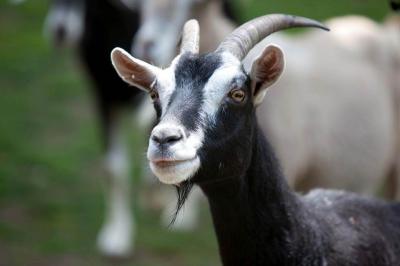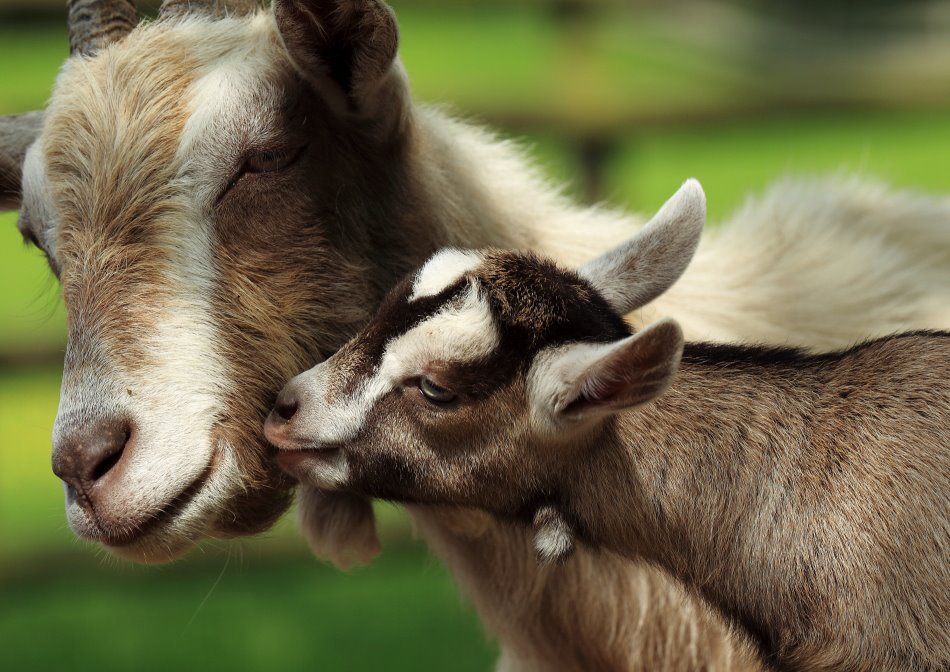Facts About Goats

Goats are stout-bodied mammals with horns and cloven hooves. There are two types of goats: domestic goats (Capra hircus), which are raised and bred as farm animals; and mountain goats (Oreamnos americanus), which live in steep, rocky areas in the American Northwest.
Goats are members of the Bovidae family, which also includes antelopes, cattle and sheep, according to the Integrated Taxonomic Information System (ITIS). Other members of the Capragenus include the ibex, markhors and turs, which are sometimes called wild goats. Mountain goats are the only living species in the genus Oreamnos.
Size
Mountain goats can weigh from 125 to 180 lbs. (57 to 82 kilograms) and grow from 49 to 70 inches (124 to 178 centimeters) long. Their black horns grow up to 8 to 12 inches (20 to 30 cm) long. They do not shed their horns, so a goat's age can be determined by counting the annual growth rings. Both males and female mountain goats have horns, according to the Animal Diversity Web (ADW) at the University of Michigan.
There are about 200 breeds of domestic goat, according to the Smithsonian Institution, so sizes vary greatly. One of the smallest breeds, the Nigerian dwarf goat, weighs about 20 lbs. (9 kg). Pygmy goats weigh from 53 to 86 lbs. (24 to 39 kg). The Anglo-Nubian goat weighs up to 250 lbs. (113 kg).
Habitat
Mountain goats are found in the Rocky Mountains, typically in Alaska, western Montana, central Idaho, South Dakota, Colorado and Washington. The wide spread of their cloven hooves allows them to climb steep mountain sides with ease. They usually live in elevations of 3,281 to 16,404 feet (1,000 to 5,000 meters) above sea level.
Domestic goats are raised all over the world in almost every type of terrestrial biomes. The main habitat requirements for a domestic goat are grass to eat and a clean, ventilated shelter, according to the ADW.
Habits
Goats are very social creatures and live in groups called herds, which may contain as many as 20 goats in the wild, according to National Geographic. Mountain goats are most social during the winter and tend to go solo in the summer. In herds, there is a dominant female throughout the year, until mating season. At this time a male dominates the herd. Many times, males only live with a few other males or by themselves, year-round.
Get the world’s most fascinating discoveries delivered straight to your inbox.
Goats typically spend their days grazing on grasses within their home range, which is an area of about 14 square miles (23 square kilometers), according to the ADW. Mountain goats will dig 1 to 1 inch (25 to 50 mm) depressions in the ground to sleep, rest and dust bathe in.
Diet
Goats are herbivores, which means they eat only vegetation. Their favorite food is grass, though mountain goats also eat mosses and plants. Many domestic goats will also eat trash, house plants or any other items they find lying around.
Goats grab food with their lips and bring it into their mouths, according to the Smithsonian. The upper jaw is wider than the lower jaw, so they can only use one side of their mouths to grind the food. This causes the rotary movement that is seen when a goat (or a cow) is chewing.
Goats are ruminants, and like cattle, they have four stomach compartments. The rumen can hold 4 to 6 gallons (15 to 23 liters); the reticulum can hold up to 0.26 to 0.5 gallons (0.98 to 1.9 liters); the omasum can hold up to 0.26 gallons (0.98 liters) and the abomasum can hold up to 1 gallon (3.8 liters). It takes 11 to 15 hours for food to pass through a goat's digestive system.
Offspring
A male goat is called a buck or a billy, unless it is castrated, and then it is called a wether. Female goats, also called nannies or does, give birth to one or two offspring in the spring after a gestation period of 150 to 180 days. Baby goats are called kids.
Within minutes of being born, kids are up and walking around. At three to four months the kids are weaned, and at 30 months they are ready to have kids of their own. Wild goats typically have a life span of 9 to 12 years.
Classification/taxonomy
Here is the taxonomy of goats, according to ITIS:
Kingdom: Animalia Subkingdom: Bilateria Infrakingdom: Deuterostomia Phylum: Chordata Subphylum: Vertebrata Infraphylum: Gnathostomata Superclass: Tetrapoda Class: Mammalia Subclass: Theria Infraclass: Eutheria Order: Artiodactyla Family: Bovidae Subfamily: Caprinae Genera & species:
- Oreamnos americanus (mountain goats)
- Capra hircus (domestic goats)
Subspecies:
- Capra hircus aegagrus (bezoars, or wild goat), found in western Asia
- Capra hircus chialtanensis (Chiltan goat), found in west-central Pakistan
- Capra hircus cretica (Cretan goat, kri-kri, agrimi, or Cretan ibex), found in eastern Mediterranean
- Capra hircus hircus
- Capra hircus jourensis
- Capra hircus picta
Conservation status
According to the International Union for Conservation of Nature (IUCN), most wild goats are considered vulnerable, threatened or endangered. For example, the Capra hircus aegagrus is considered vulnerable because of an estimated population decline of around 30 percent over the past three generations.
A cousin of the goat, Capra caucasica, or West Caucasian tur, a mountain-dwelling goat-antelope found only in the Caucasus mountains, is considered endangered by the IUCN because of an estimated population decline of more than 50 percent over the past three generations.
Goats vs. sheep
Goats and sheep are different species, and there are several physical and behavioral differences. According to Susan Schoenian, a sheep and goat specialist at the University of Maryland, on the website Sheep101:
- Goats have 60 chromosomes; sheep have 54. (Humans have 46 chromosomes.)
- A goat's tail usually points up (unless it is frightened or sick); a sheep's tail hangs down and is often shortened (docked).
- Goats are independent and naturally curious; sheep prefer to flock together and are more aloof.
- Goats' coats do not require shearing or combing (but Angora goats are sheared to provide a fiber called mohair). A sheep's woolly coat will continue growing unless it is sheared. [Related: Overgrown Sheep Gets Record-Breaking Haircut]
- Most goats have horns; many breeds of sheep are hornless (polled). Goat horns are narrow and straight; sheep horns curl around in loops on the side of their heads.
Other facts
- Mountain goats can jump 12 feet (3.5 meters) in a single bound, according to National Geographic.
- Mountain goats have bright white coats that help them blend into the snowy areas of their home ranges. Domestic goats have coats that are yellow, chocolate or black.
- Goats were one of the first domesticated animals and were first domesticated around 9,000 years ago, according to the Smithsonian.
- In bright light, the pupil in a goat's eye is rectangular rather than round.
- Goat meat — called chevon or cabrito — is eaten all over the world.
- More people consume goat milk than the milk from any other animal.
Additional resources




